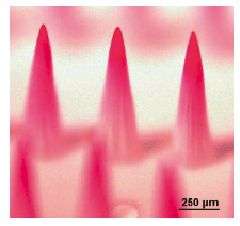Microneedles Could Replace Syringe

The common needle phobia and painful injections could soon be a thing of the past, thanks to a revolutionary new drug-delivery technique developed by a team at the Georgia Institute of Technology, US. The long-practiced method of drug administration has up to now involved the use of hypodermic needles but they have many drawbacks, including pain, risk of infection, and the need for trained staff to perform the injection.
The very few non-invasive methods of drug delivery, such as the transdermal patch, best known in its role as the smokers' nicotine patch, are unsuitable for most drugs as only very small molecules can be transported across intact skin, which excludes the large biotherapeutic molecules found in many medicines.
But what if there was another way, one that was as safe and painless as a patch but as fast and effective as an injection? In a revolutionary new study published in this month's Advanced Materials, the researchers at Georgia Tech. have designed tiny "microneedles", only five micrometers wide at the tip, which can quickly and painlessly deliver drugs into the body and are as effective as a hypodermic.
The drug, in the form of biomolecules, is encapsulated within the microneedles, which are then inserted into the skin in the same way that nicotine is released into the bloodstream from a patch. The needles dissolve within minutes, releasing the trapped cargo at the intended delivery site. They do not need to be removed and no dangerous or biohazardous substance is left behind on the skin.
The researchers chose the mechanically strong polymer poly(vinyl pyrrolidone) (PVP) to fabricate the microneedles because it is robust enough to pierce the skin, dissolves quickly, and is harmless to the body. The molding technique used to prepare the needles means that the rate at which they dissolve can be precisely tuned, depending on how much time is needed for them to travel through the body to the delivery site.
This innovative new treatment method means that vaccines, proteins, and hormones could soon be delivered into the body as effortlessly and painlessly as wearing a plaster. So could needle phobia soon be a thing of the past?
"We expect that microneedles will be able to replace hypodermic needles in some scenarios, but certainly not all cases," said Dr. Mark Prausnitz, who headed up the research. "They won't be useful for withdrawing significant quantities of blood for analysis, for example."
However, the team does expect that the microneedles will have important medical and biotechnology applications. "They are a useful way to deliver vaccines," explained Prausnitz. "Microneedles could possibly enable self-administration of the annual flu vaccine and a number of drugs, including insulin and growth hormone."
Article information: Advanced Materials, 2008, 20, 933; doi: 10.1002/adma.200701205
Source: by Sophie Ladden, Wiley





















